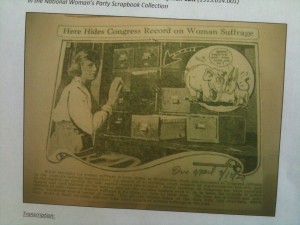I recently made an historic discovery regarding what is probably the first system to track relationships between Members of Congress and organizations that seek to influence them. Any grassroots or government relations professional knows that it is essential to have an understanding of Congress, and one of the best ways to do this is to set up a customer relationship management (CRM) system to track relationships between supporters and legislators. The tools also are used to note important characteristics or interests of the legislator that may either connect him to your cause, track meeting discussions, and note follow-up actions.
But one does not need to be a masterful 21st century practitioner of CRM software best practices to create this kind of system. In fact, I believe I recently stumbled onto the first CRM of Congress. The group had a vital issue pending before the Congress; they had a motivated and well-organized grassroots base; and they created a system for tracking every detail of their interaction with legislators as well as the interests of congressmen (and they were all men). The time was 1900. The issue: whether women should have the right to vote.
I was attending an event recently that was organized by the Sewell Belmont House, a Capitol Hill home and for a time the unofficial HQ of the suffragette movement. As I was leaving, I noticed some photographs of a card catalog system the National Women's Party had built. One black-and-white photoshowed a woman standing next to what looked like the catalog system you might find in a library. On a sample card was information about an individual Member of Congress: hometown, age, previous legislative record, interests, spousal interests (rather important to the movement), positions taken on women suffrage, and summaries of meetings with the legislator - all in one at-a-glance card. The eureka moment hit me: 'These women invented the first congressional CRM!'
This example demonstrated that the methods and strategies for influencing legislators and holding them accountable have not changed in 100 years. It shows that we get too bogged down in the details of technology. Groups and individuals seeking to influencing legislative outcomes should rely on the basics: learn about legislators and their interests (and their family interests as well); create a disciplined system for entering that information; and train all professional and citizen advocates who interact with lawmakers to collect the data. I know this isn't easy. When I was CEO of a CRM software company that allowed clients to track data on Congress, I would tell my clients one immutable fact: you can make a box with buttons do anything - but getting a lobbyist to enter information about their meeting with a key staffer, that's hard.
As March is Women's History Month, it is appropriate to pay homage to the work of the mothers and sisters who paved the way for so many other mothers and sisters to vote, participate in government, and serve in office. It seems now we should also recognize another historic contribution by the suffragettes, the first congressional CRM. One can't help but think that this system for detailed tracking of legislators had a positive effect on the passage of the 19th Amendment to the Constitution.
(Transparency Note: I co-founded Knowlegis, which is, among other things, a CRM of Members of Congress. I am no longer affiliated with the company, and this post is not a pitch for that product. In fact, as I pointed out, you don't need software. All you need is pen, paper, a really big card catalog, and a group of disciplined people committed to a cause.)



